
It’s been about five years since I’ve last done a power meter pedal comparison post. Mainly, because not much had changed in five years. The Favero Assioma will be five years old this summer (crazy, huh?), and while the Garmin Rally pedals will be 1 year old in a few weeks, those spindles are basically just the Vector 3 spindles with new pedal bodies. Further, after the SRAM acquisition, they killed off sales of the PowerTap pedal lineup. However, last month Wahoo started shipping their long-awaited Wahoo POWRLINK Speedplay-based power meter pedals.
So, combining the newishness of the Garmin Rally, with the new Wahoo pedals, and the SRM X-Power SPD pedals of early last year, it was time to dust the covers off this post concept and spin out a new version updated for 2022. Heck, at this rate you might even get a complete annual power meter buyer’s guide too!
Now, I’ll probably give you the spoiler upfront: By and large, all of these pedals covered here are solid. And realistically, the major deciding factor for most people will be either cleat type or price. Sure, there are details beyond that – but for most people, they aren’t deciders. I use all of these pedals in my testing of other trainers and power meters. So I do trust them all at this point. Something I can’t say for all power meters (or even all pedal-based power meters).
With that, let’s dive into it.
Cleats & Pricing:
First up, is the cleat types of each. This is undoubtedly the biggest decider for most people, followed closely by price.
Garmin Rally Series: SPD (Rally XC), SPD-SL (Rally RS), and Look KEO (Rally RK)
Favero Assioma: Look KEO Variant, SPD-SL
SRM X-Power: SPD, Flat Pedals
Wahoo POWRLINK: Speedplay
All four companies include stock cleats in the box for their respective pedals.
You’ll notice I say ‘LOOK KEO Variant’ for the Favero Assioma pedals. Like the now discontinued PowerTap P1/P2 pedals, the Favero pedals don’t technically use LOOK Keo cleats. They use an off-brand variant, which is very slightly different. Since Favero includes the cleats in the box, it’s not a big deal if you’re only using those pedals with your cycling shoes. However, if you have other Look KEO pedals, then you’ll see some slight difference. After years of using them, I find that I can seamlessly use my cycling shoes between legit Look KEO pedals and Favero Assioma pedals with either cleat type, as long as they’ve got a few days of use on them. That seems to break them in enough that they work just fine.
When it comes to pricing, here are the official prices of all of them for dual-sided units:
Garmin Rally Series: $1,099 for Rally SPD-SL, $1,099 for Rally Look KEO, $1,199 for Rally SPD
Favero Assioma: $719 ($589 for DUO-Shi version spindles)
SRM X-Power: $1,299
Wahoo POWRLINK: $999
Note that for the Favero Assioma DUO-Shi units, which is their SPD-SL variant, it’s a bit funky. They don’t sell you the pedals in the box. Instead, they sell you the spindles, and you have to do a brief arts and crafts project to put the two pieces together.
In addition, they also offer single-sided units, which means they only stick electronics in one side, and the other side is a dummy pedal without electronics. In all cases, they give you two pedals, but again, only one of them has electronics. All companies offer an upgrade path to a dual-sided unit, though that usually costs more (and currently, Wahoo hasn’t finalized pricing of that upgrade path, set for later this year).
Garmin Rally Series: $649 for Rally SPD-SL, $649 for Rally Look KEO, $699 for Rally SPD
Favero Assioma: $459
SRM X-Power: $999
Wahoo POWRLINK: $649
The biggest difference or benefit of the Rally system in this cleat-realm is that you can move your spindle from one Rally pedal type to another. So if you do road cycling in the summer on SPD-SL or Look KEO, but then switch to mountain biking or gravel for the fall/winter, you can simply move the spindles between pedal bodies (and that’s totally compatible with Vector 3 spindles too). I have an entire video here on how to do it, it’s pretty easy.
Note that Favero does have two different spindles between their Assioma and Assioma Duo-SHI, and you can’t swap between them. You can however take matters into your own hands though and convert the base Favero Assioma pedals from LOOK KEO to SPD (MTB), but you’ll want to be aware that doing so not only voids your warranty but also may require you trim the edges of your cycling shoes too. GPLAMA has a guide for how to do so here.
Sizing & Weights:
First up, we’ve got the weights of the pedals. Up until the Wahoo pedals, this was actually a relatively straightforward comparison. However, one of the caveats of the Speedplay platform (irrespective of power meters), is that it shifts a fair chunk of weight from the pedal to the cleat. Of course, this along with Wahoo’s removal of certain vowels makes the pedal lighter, but doesn’t make the whole system lighter, since you, of course, require the cleat for the pedal to work.
So, starting off with the weights of the pedals (shown individually), first up the Garmin row:
Then the SRM, Wahoo, and Favero pedals:
Note that for all of those, I excluded spacers, as not every crankset will require that. A single spacer is generally 1g (you’ll likely use one spacer per side):
Next, a full comparison of the weights involved (total system weight is shown for the total value):
Favero Assioma LOOK-KEO system: 382g = 152g per pedal + 39g in mounting per side
Garmin Rally Look KEO system: 404g = 165g per pedal plus 37g in mounting per side
Garmin Rally Shimano SPD-SL system: 398g = 159g per pedal + 40g in mounting per side
Garmin Rally Shimano SPD system: 512g = 221g per pedal + 35g in mounting per side
SRM X-Power SPD system: 396g = 172g per pedal + 26g in mounting per side
Wahoo POWRLINK ZERO Speedplay system: 432g = 138g per pedal + ~78g mounting (cleats/baseplate/screws)
Now, here’s how the pedals look from the front. On the first set it’s (left to right) Garmin Look KEO, Garmin SPD-SL, Favero Assioma Duo. And the second set is SRM X-Power, Garmin SPD, and Wahoo POWRLINK Zero.
Then from the spindle-side:
Then the other side:
And finally, the rear:
Obviously, the Speedplay looks the thinnest here, but again, remember that it’s a weight and bulk transfer equation. You’re simply moving that weight and bulk to the shoe from the pedal. I cover things like stack heights a bit later on down.
Installation:
The installation of these units is all basically silly easy and quick. All units use either standard pedal wrenches, or standard 8mm hex wrenches to install, depending on whether or not there are electronics in the spindle. Realistically, this isn’t much different than other pedals, which vary on whether to use a pedal wrench or a hex wrench inserted into the spindle. Also, generally, I don’t use the thinner 15mm wrench shown above, but I have no idea why all three of my normal pedal wrenches aren’t where they’re supposed to be today.
Garmin Rally Series: Pedal wrench
Favero Assioma: Hex wrench
SRM X-Power: Pedal wrench
Wahoo POWRLINK: Hex wrench
For all of these, you’ll go ahead and tighten pretty snugly. The exact torque amount varies slightly, but as a general rule of thumb for power meters, you don’t want to be loosey-goosey on any of them. Similarly though, you don’t want to do crazy overtightening either, which could damage the threads. Plus, pedals do self-tighten automatically as you pedal, so in a worst-case scenario, it’ll tighten up after your first ride.
For all pedals, I’d recommend doing 2-4 hard sprints (I prefer doing them on a trainer when installing any set of new pedals), which ensures the pedals are nice and snug. Then do the calibrations as required.
With most pedals, they need to determine their precise position. Garmin, Favero, and Wahoo all manage to do this internally with software detection, whereas SRM does require you use the app on first install to specify the exact position. Still, this is a 2-second thing while you’re setting the crank length, so it’s hardly a burden. It’ll take you more time to do the required registration/activation on the Favero pedals, than it will to do the crank angle on the SRM pedals.
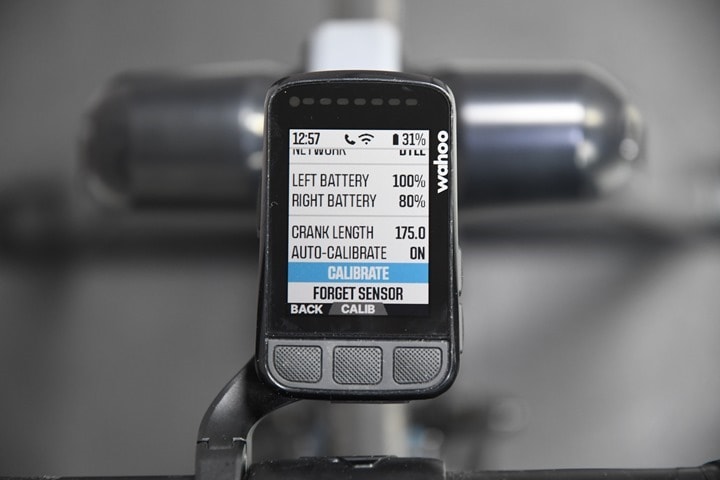
Finally, do ensure that your crank length is set correctly on any pedal-based power meter. Because the crank length is used as part of the power calculation, if your crank length is incorrect, your power output will be slightly incorrect (roughly speaking if you have 175mm cranks and don’t change it from the default 172.5mm, it’ll be about 1.8% off at 90RPM – with that gap increasing the larger the difference). Again, all of these apps ask for your crank lengths, and all bike computers will ask for it as well. But sure it’s set to the same in both places.
Factors and Stacks:
In the IT industry one says ‘rack and stack’, but that didn’t really make sense for the title here, because there are no racks. Just Q-Factors, Stack Heights, and other measurement-focused things. I think this category – more than any other – is full of specs that people think they care about, but don’t actually care about in the real world. We’ll start with the prime example of that, Q-Factor.
Q-Factor:
Q-Factor refers to the distance between the centerline of the pedal and the end of the threaded portion. Below, is an example of the Q-Factor from Favero, and for a single side. Often times this is also represented on a bike as the distance between the threads on the crank arms (both sides) – such as on an indoor bike. Technically this is actually the stance width, but hey, let’s not try and fix the internet in one day.
A lot of people get really bent out of shape about Q-Factor, but then forget that the different bikes they have in their garage for different aspects of cycling all likely have different Q-Factors/stance widths. For example, a road bike has a Q-Factor generally of ~150mm, while a mountain bike has a Q-Factor of 170mm. Jump on that WattBike? It’s got a Q-Factor of 173 but the Atom is 160. But wait, your gym spin bike has a different Q-Factor, and that’ll vary by brands and models too. Schwinn’s AC Performance is 170mm, while Keiser’s M3 is 197mm.
Not to mention that the handful of studies that have looked at Q-Factor basically all said that there’s a slight short term impact to switching distance of Q-Factor, but then like anything else your body adapts. That’s no different than any other bike component.
Still, there may be specific medical reasons why you want to keep things similar. Thus, here’s where you stand on Q-Factor:
Garmin Vector 3/Rally Series: 53mm (55mm with their stock spacer)
Favero Assioma: 54mm (55mm with their stock spacer)
Favero Assioma Shimano SPD-SL: 65mm (for reference, a stock Ultegra SPD-SL is 53mm)
SRM X Power: 54mm
Wahoo POWRLINK ZERO: 55mm (a stock Speedplay Zero is 53mm, but also offered in 56/59/65mm)
Again, keep in mind that the Q-Factor will change by up to 1-2mm depending on whether or not you use spacers, which in turn depends on your specific crank arms. Generally speaking, most power meter pedals will probably require a single 1mm spacer, depending on crank types. I usually use one for safety, merely because most crank arm types are thin enough that when the pedal is tightened on, the pedal body portion is typically slightly wider, and can overlap onto the crank-arm away from the thread-hole area, which is bad for both the pedals, crank arm, and accuracy. Also, you’ll use a spacer if your chain clearance on the other end is too tight.
Stack Height:
Speaking of stack height, this is the measurement of the center of the spindle to the bottom of the shoe. This is actually a really tough one to measure myself, due to the slight ups and downs of the pedal. So instead I reached out to all the companies to get the official stack height numbers. They are as follows:
Garmin Rally RS (Shimano SPD-SL): 12.2mm
Garmin Rally XC (Shimano SPD): 13.5mm
Garmin Rally RK (LOOK KEO): 12.2mm
Favero Assioma (LOOK KEO): 10.5mm
SRM X-POWER: 10.5mm
Wahoo POWRLINK: 13mm
Some people equate stack height to the ability to corner, but that’s actually not entirely true. It’s a blend of both the stack height and in effect the Q-Factor, since a longer spindle is really the main concern, as that’s the first portion to hit.
Float:
Just a quick note that float is actually determined by the cleats you use, and not the pedals themselves. In the case of Garmin & Favero, you’ll get red cleats that have 6-degrees of float in them. In the case of Wahoo, the cleats have adjustable float from 0-15 degrees.
Max Rider Weight:
Lastly, some pedals are limited in terms of how heavy the rider can be. Of course, there’s not truly a rider weight limit, but rather an output wattage limit. Except making that clear to consumers would be a nightmare. So instead they do math backwards a bit since in general, heavier people can output more power than lighter people with the same amount of effort.
Now there’s really two aspects at play here. First is the safety-focused aspect of the pedals breaking. But that’s not really of concern here, these pedals are pretty much fine for anybody in the ballpark of these weights. For these companies the real issue is breakage of the sensors within the pedal above a given threshold. Here’s the stated max rider weights:
Garmin Rally & Vector Series: 105 kg (231 lbs)
Favero Assioma: 120 kg (265 lbs)
SRM X-POWER: No practical limit according to SRM
Wahoo POWRLINK Zero: 113kg (250lbs)
Got all that? Good, let’s talk cornering.
Cornering:
Next, we’ve got the impact of pedal size/design on cornering. This gets to whether or not your crank arm would hit the ground while making a tight corner, likely in a race. Specifically, this is if you pedaled through the corner, and/or had stupidly placed your crank arm down on the side closest to the corner. The concern grows greater with longer crank arms, and is less of a problem with shorter crank arms. And of course, the height of your bottom bracket from the ground (higher means less likelihood of hitting).
This was a fun one to measure. In my case, I’m running 175mm crank arms, which is slightly longer than the ‘average’ of 172.5mm crank arms.
In order to measure this, I placed the arm straight down, and then measured the angle once the pedal, while flat, hit the ground. I used an iPhone with a level app that I validated first on a level surface. Then I used a phone mount to keep it stable/sturdy while doing each test consecutively. Keep in mind, these are some pretty darn steep angles. I don’t think people realize just how far you have to corner to clip here.
Here are all the pedals, as seen on a road bike (you’ll have different numbers on a mountain bike):
Or the summarized stats here:
Garmin Rally SPD: 36°
Garmin Rally SPD-SL: 37°
Garmin Rally LOOK KEO: 37°
Favero Assioma LOOK KEO: 38°
Favero Assioma SPD-SL: 37°
SRM X-Power SPD: 37°
Wahoo POWRLINK Speedplay: 39°
In a word, they’re basically a wash except for Wahoo, which offers a bit more cornering on Speedplay pedals, but like weight, that’s tricky too – because again, it’s transferred to the cleat, so you’ll undoubtedly clip on that sooner because the cleat is wider.
Now, the first thing that surprised me was that the Favero Assioma Duo-Shi (SPD-SL variant with a 10mm longer Q-Factor) was virtually identical to the base Assioma. The SPD-SL variant was 37° (though occasionally flickering at 38°), whereas the stock Assioma is 38°. Again, despite being 10mm longer. However, the key is looking at the underside of the pedal, where the Ultegra Pedal tapers significantly at the edge (obviously, to avoid this very issue). Whereas the Assioma pedal is basically a vertical wall at the underside edge – making the cornering angle far less than it would be with a tapered design.
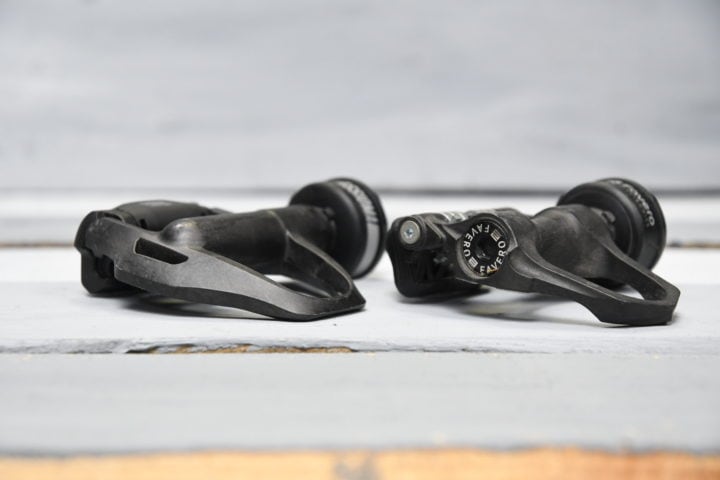
The second thing that surprised me doing it this time around was the difference in cornering angles to my previous bike. In a past test of this, I was getting 27-29° of cornering, but on this Cannondale bike I’ve been testing for something else (this bike was the closest to my camera when I started this fiasco), I was getting 36-37°. So, out of curiosity I then put my Canyon bike up against the Cannondale bike, and despite having the same crank lengths, the bottom bracket is just slightly higher on the Cannondale, and every millimeter higher means a huge amount of extra cornering angle. So roughly 2mm higher bottom bracket led to a 10° higher cornering angle. Crazy!
In any case, I showed this same tactic in numerous other reviews, and to date, I’ve seen only one person state they’ve hit their pedal on the ground while cornering (to which someone else immediately pointed out they’d probably have hit that pedal anyway, regardless of the slight increase in stack height). And now we’re some 7+ years down the road on power meter pedals, and this simply isn’t a real-world issue for 99.99% of people.
Battery and Broadcasting:
Next, we’ve got a slate of technical details from battery to broadcasting, including aspects around ANT+ & Bluetooth Smart standards. First up is how the darn things are powered.
Battery:
Each of the three pedals uses different battery options, along with different power outputs. To simplify this, here are the three models:
Garmin Rally: 2xCR1/3N (one per side) coin cell batteries
Favero Assioma: Rechargeable battery, encased, not swappable
SRM X-Power: Rechargeable battery, encased, not swappable
Wahoo POWRLINK: Rechargeable battery, encased, not swappable
The CR1/3N battery isn’t super easy to find ad hoc in grocery stores/gas stations, so you will want to plan for that with perhaps an extra in a saddlebag if travelling. Equally of course, if you forget your charging cable for the others, none of them are standard – so you’re definitely hosed there. Favero, Wahoo, and SRM all have detachable charging connectors, which then plug into either USB-C (Wahoo) or Micro-USB (SRM/Favero) cables.
As for battery life, you’re going to have to go with claims here as the standard. Based on my testing, as well as others, all of these seem to be in the correct ballpark insofar as real-world experience. Of course, things like temperature will impact that – but nobody at this point is an outlier when it comes to missing the ballpark of their claims.
Garmin Rally: 120 hours (with Cycling Dynamics enabled)
Favero Assioma: 50 hours
SRM X-Power: 30 hours
Wahoo POWRLINK: 75 hours
Note that SRM’s official claim is 30 hours, though in theory on their newer hardware internals, it should be getting in the 40-50hr range. I haven’t tested the newer battery internals though.
Now, when it comes to rechargeable batteries, some have concerns. I’m going to quickly copy/paste what I wrote in the Assioma review below – since it really applies to all units. But ultimately it’s just a personal preferences thing.
From the Favero Assioma In-Depth Review: I’ve seen some concern about what happens when the batteries ‘die’, apparently in reference to how you might swap them out. Some of this is due to misunderstandings about how rechargeable batteries die. First off is that batteries are generally rated to a certain number of recharge cycles, in the case of the Assioma battery, that’s estimated to be about 500 cycles (per Assioma). Once it reaches that number, they don’t stop working. Instead they might slowly degrade, perhaps to 80% of battery capacity. With a battery life of 50 hours, and the 500 recharge cycles, that puts you at 25,000 hours of battery life before it starts to degrade. That’s 24 years of riding 20 hours per week. Or almost 50 years if you rode 10 hours per week. Seriously, you’ll have long moved onto something else by then. Battery cycle time is not your concern here.
Status LEDs:
All four units contain status LEDs that allow you to validate basic operation. These lights are also used for things like firmware updates and such to let you know what’s going on. On the Rally and SRM pedals you can see it at the end of the spindle (green light), on the Favero & Wahoo pedals, the lights are on the pods themselves. Also, getting this picture with all the LEDs illuminated took an astounding amount of time.
Basic ANT+/Bluetooth Smart Connectivity:
Next is how and what each unit transmits, starting with the most basic things in this mini-section, and then moving to the more complex stuff in the next mini-section. Simply put, all three units broadcast all the same core fundamentals. They almost all broadcast the following data via the ANT+ & Bluetooth Smart standards:
ANT+ Total Power
ANT+ Power Balance (Left/Right)
ANT+ Cadence (RPM)
ANT+ Torque Effectiveness [Not Wahoo]
ANT+ Pedal Smoothness [Not Wahoo]
Bluetooth Smart Total Power
Bluetooth Smart Power Balance (Left/Right)
Bluetooth Smart Cadence
There are no official standards for Bluetooth Smart Torque Effectiveness or Pedal Smoothness at this time. Note that all units allow for unlimited concurrent ANT+ connections (e.g. a bike computer and Zwift both connecting at the same time). On the Bluetooth connection side, Favero and SRM only allow a single concurrent Bluetooth Connection. Garmin allows for two concurrent Bluetooth connections, and Wahoo allows for three concurrent Bluetooth connections.
When it comes to head units, within the core settings above, all reputable head units support all these different items. One caveat though is Bluetooth Smart-only head units can be a bit more tricky, as oftentimes they’ll only pair to a single side of a dual sided power meter. This can manifest itself in weird ways on certain older watches and bike computers (especially older Polar & Suunto watches).
As a general rule of thumb, most in the power meter industry would recommend using ANT+ over Bluetooth Smart when connecting to your head unit, despite the unit broadcasting both. The exception to that being if you experience drop-outs from your power meter to head unit (none of the units here though are prone to that), in which case you could try to see if Bluetooth Smart will resolve the drop-outs.
Of note is that metrics like TSS (Training Stress Score), NP (Normalized Power), and many others are not at all power meter model dependent. Rather, they are dependent on the specific head unit and/or training platform you use.
Advanced Pedaling Metrics:
Now in addition to the core power metrics seen above, two of the models have different advanced metrics that can be shown. These include Cycling Dynamics, which both Garmin and Favero leverage using that standard profile (albeit, to different degrees). SRM also has some advanced pedaling metrics, though those are only visible within their specific app.
Cycling Dynamics: This previously started off as a Garmin-only thing, but then was brought forth into an ANT+ standard. These metrics are displayable on a head unit (albeit at present, only Garmin has implemented it) as well as later on in Garmin Connect. Further, 3rd parties can also display the data too. These metrics span a wide number of areas from platform center offset to seated/standing time. Some of these metrics can be used in bike fit, while others are clearly more geek-oriented.
First up, is all the charts you get on a normal ride – you’ll see the cadence/power/balance, and then the seated/standing position bits of Cycling Dynamics are mixed in there. Below is what you’ll see from a pair of Garmin Vector or Rally pedals:
As you scroll down, you transition entirely into the Cycling Dynamics related bits (Platform Center Offset, Pedal Phase):
But there’s also a secondary tab there, to see all the Cycling Dynamics information:
For example, I can tell you my max and average power for both while I’m seated versus standing. There’s likely something to be learned from that, but mostly it’s just a fun geek stat – I don’t use it day-to-day. Whereas aspects like PCO (Platform Center Offset), could be useful for looking at whether or not your bike fit is proper.
In total there’s a massive list of Garmin Cycling Dynamics metrics that you can add/record. They are:
PCO, PCO – Avg, PCO – Lap, Power Phase – L, Power Phase – L. Avg, Power Phase – L. Lap, Power Phase – L. Peak, Phase – L. Peak Avg, Phase – L. Peak Lap, Power Phase – R., Power Phase – R. Avg, Power Phase – R. Lap, Power Phase – R. Peak, Phase – R. Peak Avg, Phase – R. Peak Lap, Time Seated, Time Seated Lap, Time Standing, Time Standing Lap, Average Power Standing, Max Power Standing, Average Power Sitting, Max Power Sitting, Average Cadence Standing, Max Cadence Standing, Average Cadence Seated, Max Cadence Seated.
Now, with all that backstory, note that while Garmin Vector/Rally support all of these metrics, specifically the Favero Assioma pedals do not support Platform Center Offset (PCO). Wahoo doesn’t support any of them, as they stated they don’t see value in them. Instead, Wahoo says they’re working on some other form of advanced pedaling metrics for down the road. But no timelines or details are available for what that might be, or when it might show up.
Power Accuracy:
There are countless bad power meters in the power meter industry, both ones in production – but mostly ones that never quite made it to production. However, this set of four power meter pedals don’t fall into the bad-camp (no relation to band-camp). I use and have used all four sets of these pedals for extended periods of time (nearly a year for Wahoo POWRLINK, more than a year for Garmin Rally, nearly two years for SRM X-Power, and nearly five years for Favero Assioma) – and all of them are solid on accuracy across a wide variety of scenarios. Note that in the case of the SRM pedals, that goodness statement only applies to the SRM X-Power series, and not their SRM EXAKT Look-KEO series from previous efforts, which I don’t trust at all (that was a collaboration with LOOK, based on older technology as part of a collaboration from Polar many years prior).
Officially each company makes slightly different accuracy claims:
Garmin Rally: +/- 1.0%
Favero Assioma: +/- 1.0%
SRM X-Power: +/- 1.5% (this is also listed as +/- 2.0% in some places)
Wahoo POWRLINK: +/- 1.0%
Which isn’t to say that every single ride I’ve done has been perfect. With enough rides over enough years, I can usually eventually find some quirky one-off ride that doesn’t fit the mold of expectations in some nitpicking way. But that’s also true of virtually every power meter or trainer on the market, some more than others. However, I have no issues with taking these units out and using them either day-to-day for training – or more importantly in this context, day-to-day for accuracy testing – especially if you follow simple pre-ride zero-offset procedures.
Comparison Tables:
This section is a more simplified version of this post. Basically, it’s the core differences between all these units in one tidy place. However, this chart below is actually pulling from the larger product comparison database, with numerous other power meters of other types in it. You can always make your own comparison charts in the product comparison database, but for simplicity I’ve included a couple of main comparisons below.
| Function/Feature | Wahoo POWRLINK ZERO (Dual-sided) | Garmin Rally Series | Favero Assioma Power Meter Pedals (Dual) | SRM X-Power |
|---|---|---|---|---|
| Copyright DC Rainmaker - Updated January 7th, 2025 @ 3:39 pm New Window | ||||
| Price | $649/$999 | $649/$1,099 (SINGLE/DUAL) | $459/$719 (single/dual) | $999/$1,299 (SINGLE/DUAL) |
| Available today | Global | Global | Global | Most major markets |
| Measurement Type | Direct Force | Direct Force | Direct Force | Direct Force |
| Attachment area | Pedal | Pedals | Pedal | Pedal |
| Attachment limitations | Speedplay cleats | SPD/SPD-SL/LOOK KEO | LOOK KEO COMPATIBLE CLEATS ONLY | Shimano SPD |
| Weight (additional/net) | 133g per pedal (plus cleat weight) | 159g SPD-SL/165g KEO/221g SPD | 150g per pedal (inclusive of pods) | 172g per pedal |
| Wireless Connectivity Type | ANT+/BLUETOOTH SMART (DUAL) | ANT+/Bluetooth Smart | ANT+/BLUETOOTH SMART (DUAL) | ANT+/Bluetooth Smart |
| Unit auto-turns on when on bike | Yes | Yes | Yes | Yes | Battery | Wahoo POWRLINK ZERO (Dual-sided) | Garmin Rally Series | Favero Assioma Power Meter Pedals (Dual) | SRM X-Power |
| Battery Life | 75 Hours | 120-150 hours | 50 Hours | 30-40 hours |
| User or Factory battery replacement | FACTORY (SUPPORT ISSUE ONLY) | User | FACTORY (SUPPORT ISSUE ONLY) | Factory (support issue only) |
| Battery type | Rechargeable | CR3/1N | Rechargeable | Recharageable |
| Low Battery Warning | Yes | Yes | Yes | Yes | Features | Wahoo POWRLINK ZERO (Dual-sided) | Garmin Rally Series | Favero Assioma Power Meter Pedals (Dual) | SRM X-Power |
| Measures/Transmits Cadence | Yes | Yes | Yes | Yes |
| Ability to update firmware | Yes | Yes | Yes | Yes |
| Transmits Left/Right Power Balance (Measured) | Yes | Yes | Yes | Yes |
| Transmits Pedal Smoothness | No | Yes | Yes | Yes | Accuracy | Wahoo POWRLINK ZERO (Dual-sided) | Garmin Rally Series | Favero Assioma Power Meter Pedals (Dual) | SRM X-Power |
| Measures all power output | Yes | Yes | Yes | Yes |
| Claimed Accuracy Level | +/- 1% | +/- 1% | +/- 1% | +/- 1.5% |
| Includes temperature compensation | Yes | Yes | Yes | Yes |
| Supports auto-zero function | Yes | Yes | Yes | Yes |
| Supports manual calibration | Yes | Yes | Yes | Yes |
| Supports hanging weights (static test) | No | Yes | Yes | Yes | Software | Wahoo POWRLINK ZERO (Dual-sided) | Garmin Rally Series | Favero Assioma Power Meter Pedals (Dual) | SRM X-Power |
| Phone App to Configure/Test | Yes | Yes | Yes | Yes | Purchase | Wahoo POWRLINK ZERO (Dual-sided) | Garmin Rally Series | Favero Assioma Power Meter Pedals (Dual) | SRM X-Power |
| Amazon | Link | Link | ||
| Backcountry.com | Link | Link | ||
| Competitive Cyclist | Link | Link | ||
| REI | Link | Link | ||
| Other | Link | DCRainmaker | Wahoo POWRLINK ZERO (Dual-sided) | Garmin Rally Series | Favero Assioma Power Meter Pedals (Dual) | SRM X-Power |
| Review Link | Link | Link | Link | Link |
And again, remember you can always make your own comparison charts in the product comparison database.
Wrap-Up:
In many ways, this is part long-term review, and part buyer’s guide. I’ve had all of these pedals on bikes for really long times. Both in terms of bikes that I use within my testing rotation, but also on my ‘primary’ bike that I use for general riding. Starting with accuracy, as noted above, I can swap between any of these pedals and know that I’ve got a good accuracy baseline to work from.
The next bit is reliability and dependability in terms of battery life and connectivity. And again, most of these are solid – with only the SRM X-Power being on the lower end by a fair chunk. It’s got other weight benefits in the SPD realm compared to Garmin’s offering, which may be a consideration for you. But in terms of reliability of the pedal waking up and doing what it’s supposed to do – all of these fit that bill. And I don’t see dropouts or connection issues with any of these, using reliable bike computers/watches.
Next, we’ve got the mechanical side. Again, all of these pedals I (and many others) have put through countless hours or years of usage without much issue from what I’ve seen. If we look at the Garmin Vector 3 issues around battery caps, that was solved more than a year ago with new stronger caps that accepted new battery types to eliminate that issue (and downstream issues), which is in turn the exact same cap that Rally uses.
After those, we have cleat-related stuffs. Obviously, that’s going to depend on what you use. However, if you do use multiple cleat types throughout the year and want flexibility to switch between those, the Garmin Rally system is the only option that does that. But that does depend on you having some seasonality to your bikes/cleats. And realistically, it’s far cheaper to get a crankset-based power meter for a secondary bike in most cases – especially for mountain or gravel bikes that have a single chainring.
And ultimately, with the exception of the Favero pedals, for most of the other pedal systems here, you can often buy two crankset spider-based power meters (not crank-arm ones) for the price of many of the dual-sided pedal systems. Crank spider systems give you correct total power, and aren’t susceptible to some of the crank-arm accuracy issues on newer Shimano cranks. Which, isn’t meant to convince you that pedals are wrong after reading a giant post on pedal-based power meters, it’s to point out pedals aren’t the only option.
There’s good reasons to get pedals – namely portability, the ability to move them between bikes. Or to take it with you when you travel without a bike to stick on a rental. I’ve done that countless times when I’m just taking my helmet/shoes/pedals with me, instantly adding power to whatever bike I get. But beyond portability, there’s also sidestepping crankset/frame compatibility issues. There are plenty of cranksets or bottom brackets that aren’t super compatible with the power meter of your choice, and again, pedals deliver that.
And the good news is that, here in 2022, we’ve got plenty of good pedal options for power meters that are reliable and accurate. Which, in a power meter, is what matters.
With that – thanks for reading!
Found This Post Useful? Support The Site!
At the end of the day, I’m an athlete just like you looking for the most detail possible on a new purchase. These posts generally take a lot of time to put together, so if you're shopping for the Garmin Rally Series, Wahoo POWRLINK ZERO (Dual-sided), Favero Assioma Power Meter Pedals (Dual) or SRM X-Power or any other accessory items, please consider using the affiliate links below! As an Amazon Associate I earn from qualifying purchases. It doesn’t cost you anything extra, but your purchases help support this website a lot.
And of course – you can always sign-up to be a DCR Supporter! That gets you an ad-free DCR, access to the DCR Quarantine Corner video series packed with behind the scenes tidbits...and it also makes you awesome. And being awesome is what it’s all about!

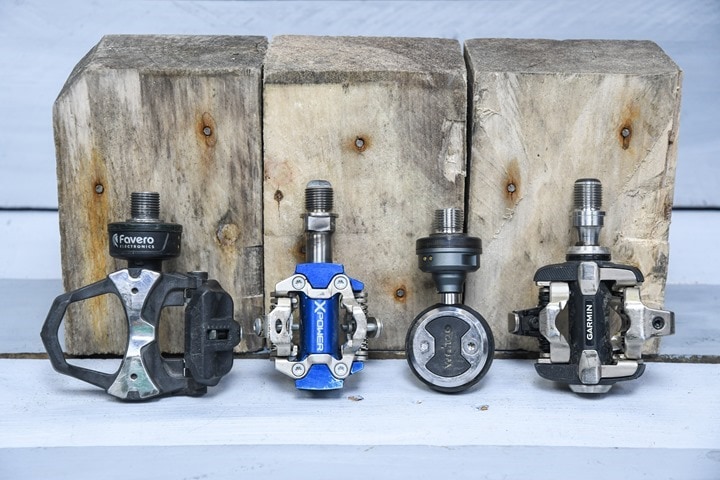

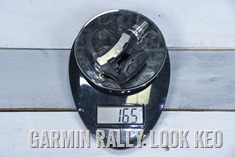

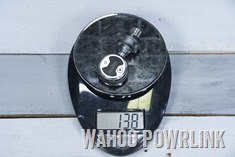

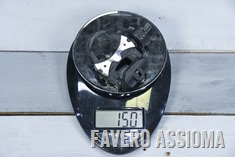
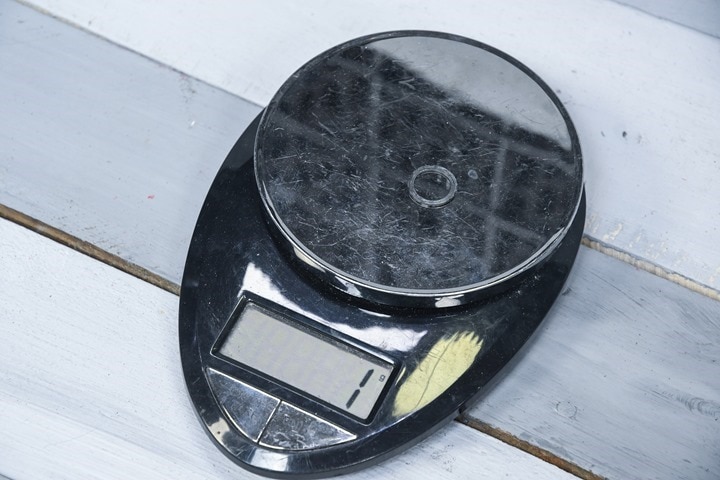
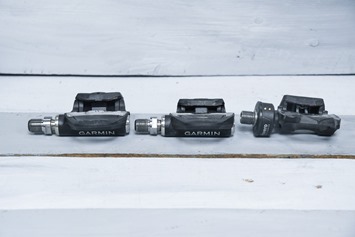
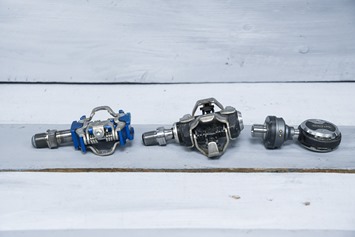
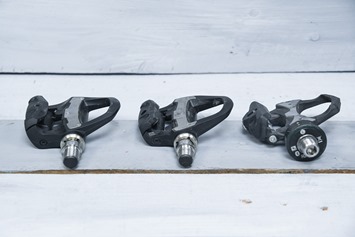
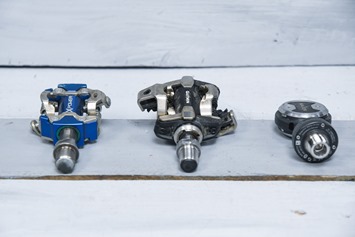
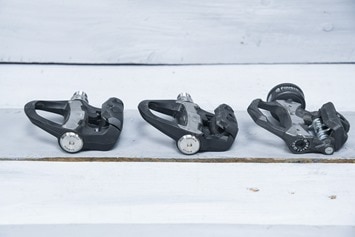
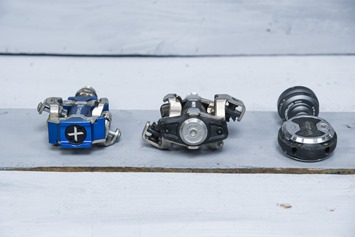
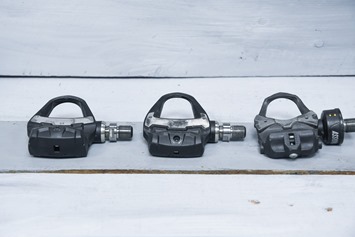

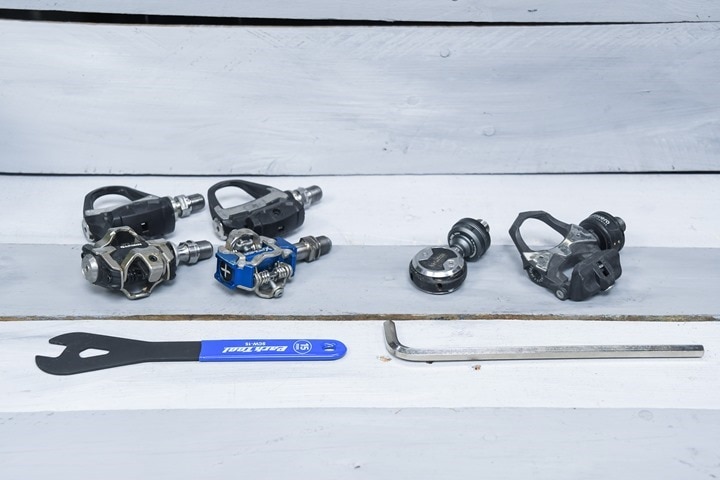

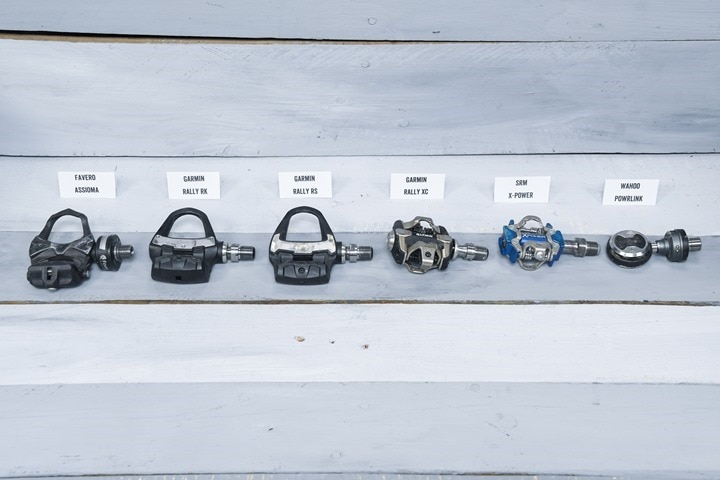
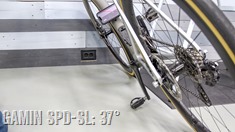
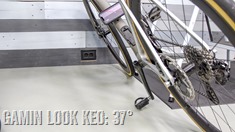
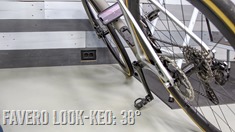
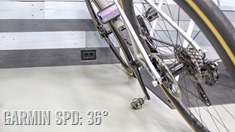
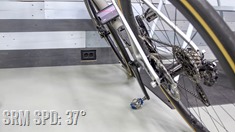

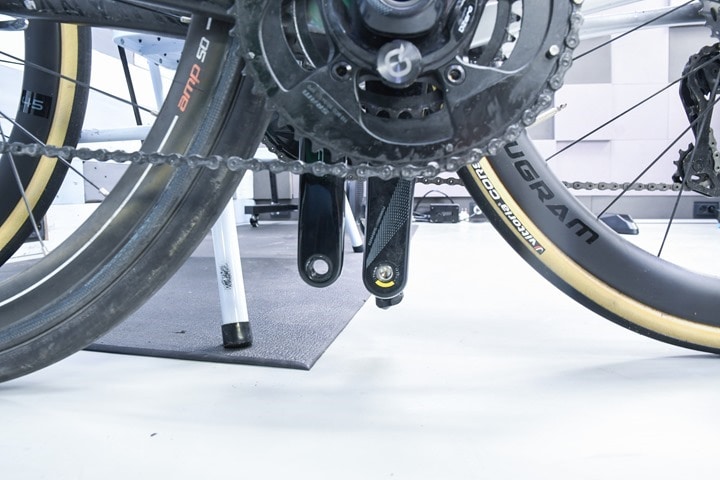

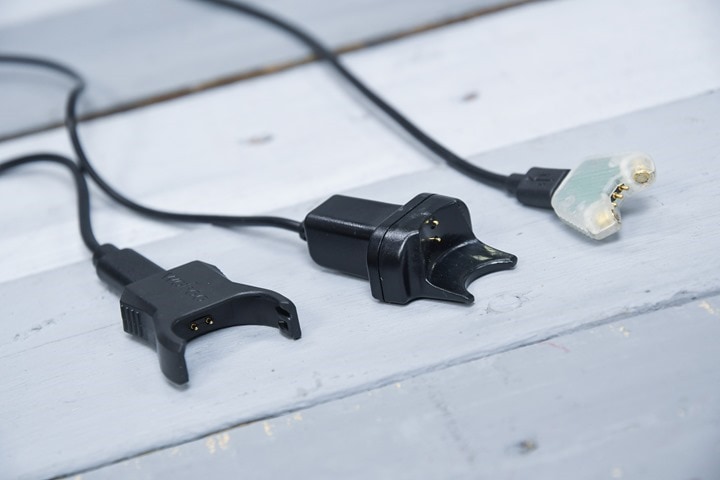






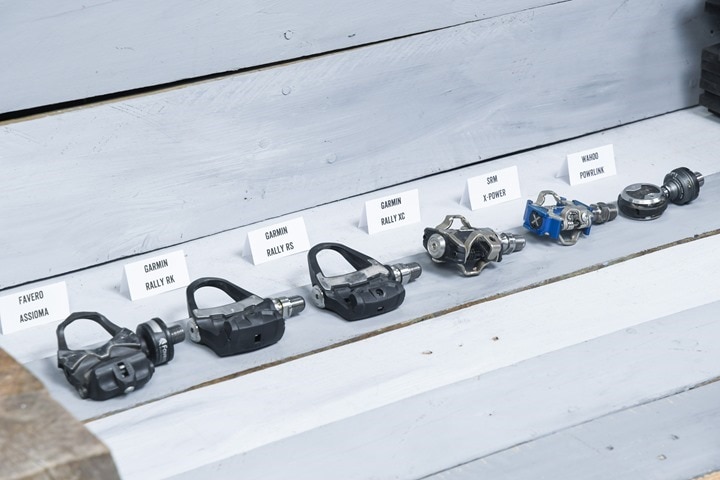

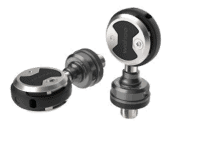
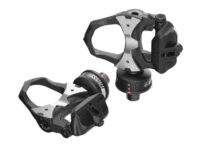
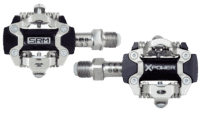





















I am still using a pair of Powertap pedals, which are about 7 years old. Although they are still working well, I expect that they will come to the end of their life soon. After using a couple of types of power meters, I am partial to the pedal-based ones, mostly because of the ease of moving them between bikes. I like the fact that Wahoo has a product, but why would they limit themselves to only offering a speedplay version? Are they planning to release a Keo-style setup?
If you wanted KEO style cleats, why would you go Wahoo over Assioma? Seems like Wahoo’s main market entry point here is people who like Speedplay pedals, so I think it makes a lot of sense to me that they corner that market. On group rides I ride I’d say 20% of riders are running Speedplay, so that’s a decent segment to lock in.
Wahoo bought Speedplay so it isn’t surprising they came out with a speedplay power meter pedal.
Given all the effort to make a power meter pedal, I wouldn’t be surprised if they came out with Keo, SPD, SPD-SL. They did a lot of the hard work already so it would be worth it to come out with non-Speedplay options. I have no inside knowledge, though.
Not a Speedplay enthusiast myself, but I do hope they focus on optimizing that offering even if they do branch out into other pedal types.
I would like to think the cleat & shoe options could be improved a bit more.
Ray, Do you know if it is possible to retrofit the Fevero or Garmin spindle to the Look Keo Carbon Blade pedals?
I’ve ridden Assioma’s for 4 years, both indoor & out. This year, they are now strictly indoor. I gone with the Garmin SPD’s for outdoor. Last season, I had a mechanical out in the boondocks and had to walk several miles in the KEO cleats. Not fun.
I’m no longer competitive so losing a few watts with the SPD’s isn’t going to have a noticeable effect. I ride Crank Bros. on my commuter bike so there was no learning curve with the SPD’s.
The power numbers are spot on with both pedal types. Walking with SPD compatible shoes, even stiff soled, is much easier. If Assioma had introduced an SPD type pedal last year, I would have gone in that direction. I’m familiar with the work around for these pedals but that’s not for me.
I’m pleased with both sets of pedals. Go with your preference. There’s no bad choice.
Hi David B,
Been looking at replacing my Assioma’s since, after 4 years, I have started getting sporadic power readings (far too high) and pedal balance (30-70 with one shoe unclipped!). Interested if you ever encountered anything similar.
Ray – Good comparison, thanks. I asked this over on the Powrlnk review, do we know the upcharge for upgrading the Wahoo single sided to dual sided yet?
Not yet. In my talking with them, they implied that it’ll be cheaper to get the dual-set upfront, than to add the upgrade later. For reference, it basically costs $100 more in a Garmin setup to do that (total cost). I’d imagine Wahoo is probably going to be in the $50-$100 range (total extra cost).
Thanks for being a DCR Supporter!
Thanks for a nice buyers guide. One question. Is any of the SPD-versions (SRM of Garmin) compatible with knee savers?
Is that an alternate name for the metal Pedal Extenders that fit between the pedal and crank arm, to lengthen the effective stance width on the pedals?
Yes, “knee savers” = “pedal extenders”.
I can vouch for the fact that the Garmin pedals with pedal extenders. I run the Garmin SPD-SL pedals with a 20mm extender and they track perfectly with my Power2Max crankset powermeter.
The only downside is that it’s a little tough to see the light indicator at the end of the pedal. However, anything you would want to see there can easily be accessed through the Garmin Connect app.
Interesting. Mayby time to do an investment in a pair of Garmin dual sided SPD-pedals + knee savers, which I then move from bike to bike.
Great review of all of the PM’s listed… I’d only opted to edit one thing… while the overall Q-Factor distance of the AF-DUOSHI, is only 10mm (on either side) and as written generally considered negligible to riders – not every rider. I waited for these PM’s to become available and jumped right into the deep in of the pool… two months later, and after three separate bike fit adjustments, plus a sore knee, I sent them back. The folks at FA, who I stayed in constant contact with about it were kind enough to let me exchange them for the LOOK pedal PM’s… No problems since… I’m a fan of this PM system… easy to install, easy to manage, easy to charge (if you ride anywhere from 10-15 hours a week, I’ve found the battery lasts a hair under 30 days before it dips into the yellow where you should recharge it… so that’s three easies in a row, which equates to nine (out of 10 max) gummy bears on the GB evaluation board… LOL
That was supposed to be “FA-DUOSHI”… too much Starbucks… smh
Do you have any sense for how each model performs/compares in max sprints, specifically peak power and response times (does one model more accurately register sudden increases in power more quickly)? Or is one format of power meter better than another for measuring this (i.e. pedal vs. crank arm vs. spider-based, etc.; not counting the expected differences due to placement at different points along the drivetrain)? I also realize when we are talking a 1-10 second measurement period, it doesn’t give a whole lot of time for any idiosyncracies in broadcast timing to settle out.
Has anyone managed to find a flat pedal body that works with the Assioma Duo-Shi?
I know there’s the SRM as an option, but WOOF at that price.
I use mine with a pair of Shimano EH500 hybrid flat/SPD pedals. There might be some Shimano flats that have the same axle dimensions.
@RG1X Looking at Shimano exploded views (not from trial/error testing) two pedals look like a maybe: the MX80 and MX30.
You can use the non SHI with many iSSi pedals. I have used the trail flip iii and it works well.
Paging GPLAMA to the room for a new video…
Thank you so much for this comprehensive comparison.
Love my Favero Duo. I wish Wahoo would use the pedal stats somehow. It’s odd using Garmin Connect to see pedal dynamics information. That being said, at my age and skill level, pedal dynamics are just pretty numbers in the galaxy of data collection. I doubt whether an analysis would really help me improve. Be wonderful if it did.
I was going to get a new Favero Duo and do the Lamakenstein conversion of the old pair to SPD for use on gravel bike. Ultimately it was easier to get a GRX left crank 4iiii power meter. Works just fine. The Favero stays on the road bikes.
Yeah, I continue to wish that someday, any day, Garmin would put together a detailed ‘Training and Racing with Cycling Dynamics’ type white-paper. I’m not asking for a 384-page book like Hunter Allen”s (link to amzn.to), but just a few dozen pages of semi-science backed (or at least data-driven) statements.
For example, fitters have been using PCO for quite a while now. But surely Garmin has tons of ‘trade-show-tidbits’ on those uses. Meaning, tidbits that they pick up at trade shows where a fitter says “Hey, here’s what I’ve learned about using PCO in my fittings over the last 5 years”. Consolidate that stuff. Or other things from coaches that they undoubtedly have. In other words, give me a reason to find Cycling Dynamics valuable aside from geekery.
Thanks for being a DCR Supporter!
Thanks for this, Ray – it comes at a good time for me as I’m finally considering investing in power for my road/gravel bike. I think the fact that I’m so heavily invested in the Garmin system has swung the day…but even more so, the idea that I could switch the pedal bodies around with almost no effort is really compelling.
Thanks for being a DCR Supporter!
Indeed, it does make it easy to switch cleat teams down the road – either due to preferences, or simply seasonality.
Being an SPD guy I wonder why Rally SPD variant is $100 more expensive than Rally SPD-SL / Rally Keo?
I’m not sure exactly, though my guess would be either:
A) Slight material cost increase due to more durable design
B) Garmin realized that there’s really no other power-based pedal meter on the market at that price point, so I suppose they just decided to charge more (sorta like with the Tacx NEO Motion Feet).
Thanks for being a DCR Supporter!
Because they compete with the SRM’s and it’s the same price.
Nice write up!
One remark.
Although you do mention the heavy weight of the Speedplay cleat, you should have weighed pedal + cleat instead of just the pedal IMHO.
Thanks!
Though, I did. ;)
I put a huge chart right below the pictures, which show the total system weight – including the cleat components individually.
Thanks for the review. I’m using favero since 2018 and i’m really happy with them. one of the reason of the choice was that they were compatible with oval chainring.
“Whereas Favero’s charging connector is affixed to the longer cable portion.“
You might want to look again, it’s a micro-USB adapter, just oddly shaped. I charge my Garmin and lights with the conveniently long Favero cables all the time
(minus adapter it’s the same cable they sold with the Bepro, bike looks like something from Johnny Mnemonic when all four of them are jacked into some battery)
Holy cow, you’re right! Nice catch!
(And, thanks for being a DCR Supporter)
Some things are easily missed in the first five years of regular use ;) That’s not even a decade!
About the cornering, if the difference is really just a millimeter, that’s easily clipped off.. by cornering. The clipped surface looks much cleaner than I’d expect: if it was symmetric (apparently I only strike pedals on the right side) you wouldn’t know that the plastic want molded in that shape.
Yeah, it’d be interesting to know what angle people typically corner at in a crit. Of course, that all implies someone is ‘tired’ enough to try and corner while pedaling through the corner at such angle.
I just look back at all the comments over the last 9 years, and we just really haven’t seen any meaningful number of comments around people clipping power meter pedals anymore than regular pedals. Perhaps slightly more on the beefier P1/P2, but that’s about it.
Did you do the cornerning test with the assioma-shi at all? I’d assume that the extra q-factor could be an issue here – probably more so than any bike fit differences.
No, I completely forgot. Will do it in a second though.
37*, versus 38* on the Look Keo. Which was surprising at first, and then I looked at the pedals side by side, and the Ultegra pedal tapers a crap-ton at the edge. Versus the stock Assioma Keo pedal is basically a wall at the edge. Will stick a photo up above in a few.
For me, using the Rally XC200, a bigger concern is the ability to tolerate rock strikes. So far so good for me. Two or three decent hits on big rocks and the pedals are barely scratched and still work just fine. The power matches my trainer exactly the same as when brand new. I have no idea how you would quantify the rock strike resistance capability.
Maybe not relevant here but genuine Look Keo 2 pedals have a ton of cornering clearance, much more than the Favero (Xpedo?) versions. I ride both and had Xpedos in the past.
Hey Ray – I’ve clipped my Assiomas coming around a small roundabout at speed but only once (that was enough since I would have gone down in front of a car!).
We have a crit course in Melbourne (the Teardrop) where pedal strike is almost a weekly occurrence. You can see how tight it is on the best line: link to usnats.s3.us-west-1.amazonaws.com (photo is my daughter racing there).
Then you didn’t hit a rock hard enough. I already broke the lower front mechanism at a hard impact, and had to get a new pedal body.
I have been racing for three years with my Assioma’s and all my pedal bodies have your standard crit racer hits on the pedals and I have had no issues with rebuilding the bearings (there is still plenty of thread left after my hitting the pedal in the corners mods…lol) I am on my completely 2nd replacement set of Assioma’s due to…..yes battery issues. Both of my pedals completely died after about 35k miles and would not hold a charge. I had the extended warranty with Assioma and they took care of me…..however with my “new” set of pedals Assioma will not allow me to purchase their extended warranty and they are a completely new pedal set. I understand they would not give me a warranty but I am willing to purchase one and they have told me twice now…NO. That is a huge disappointment since the last extended warranty did help with my battery failure.
Lets talk about the most important thing of the video…
Where did you get that shirt!
should be on the notes!
link to threadandspoke.com
You owe me forever….😂
Pls. tell favero to make the Uno-Shi already!
Do you have any information on how the pedal stack heights, err, stack up after accounting for cleat thickness? Look cleats seem to be considerably thicker than SPD-SL cleats, so I wonder that effect that has. After all, it’s the axle-to-shoe distance that ultimately matters.
I tried measuring this myself, but as you say, it’s surprisingly difficult to get a fair comparison.
Pedal-based meters seem like a good option for non-standard cranks. I’m currently using 135mm cranks – what is the range of supported crank lengths, if that’s available?
Hi, just wondering if you even found out more about this – I use 140mm cranks. Thanks
Are there any rumors an Official Favero SPD pedal?
I was wondering this as well. I have to imagine a lot of people are in the same boat as us.
So if I’m sitting…..my weight isn’t an issue. Stand to sprint, now my weight supposedly is an issue, except as I push that lever down, the crank flexs, the bottom bracket flexs, the rear wheel flexs, the tire compresses, and squirms…the chain takes up some wattage, the spokes twist etc etc. On a powerhub wheel I have seen 1400+ watts, I can routinely break 1000 (p.s. all for literally SECONDS at a time :)) yet pro riders can easily sprint upwards of 2000 watts. So its a ‘item’ that breaks? a literally manufactured piece of something that I would be able to destroy INSIDE a pedal with my 1000 watts because I’m heavier than a ‘weight limit’ yet I’m sure pro’s are putting down much more wattage. I am really confused over these ‘limits’ I HAVE broken crank arms and chains, even a frame, In the old days I could make a bike shift by flexing the bottom bracket. Now, however I can literally break soemthing inside of a pedal, but NOT a srm pedal? LOL confusion reigns and it feels to me like they just have not tested anything with heavier riders so it is easier to say it cannot then spend the time (and money) to figure out where the limit really is.
The limit case for a pedal vs rider weight is not sprinting, it’s when you’re standing up and have all your weight on the pedals. To optimize strength vs pedal weight, the designers fix a weight limit, add a safety factor, and go from there. That’s where the weight limit comes from.
Garmin has a 100$ rebate program going on… at least in Canada: link to static.garmincdn.com
Well the SRM X-Power Flats finally solves my loaded, self-supported, cross country touring use case. My touring bike has a triple front crank and a 36-spoke rear hub… neither of which are supported by today’s power meters. I’ve been known to travel in hiking boots and stop often for excursions or ice cream, so flats are ideal.
But $1,500 for flat pedals? Are you freakin’ kidding me?!
I suspect at some point Garmin will offer a flat options considering they already allow you to swap and use 3 different bodies/interfaces on the same spindle.
On the topic of batteries for the Garmin Rally, you can use 2 pieces of A76 (also known as LR44) per pedal instead of a CR1/3N on each pedal. The A76 / LR44 batteries are as common as dirt
I stopped reading when I read the Speedplay cleats will hit the floor before the pedals do….jeez.
I know you don’t like the Wahoos, probably because they haven’t given you a bung but don’t spout BS just for the sake of it. Amateur.
I wonder when you left this comment if you stopped to ponder – for just a split second, that you might actually be wrong? That perhaps in all your internet prowess, that maybe – just maybe – you might not actually know what you’re talking about? Or maybe, that you never stopped to look under your pedal when it’s about to clip?
No worries, I’m used to idiots by now. But, for the sake of your humiliation, I’ll leave your comment (with its fake e-mail address), and then also leave this image that very easily demonstrates that you actually hit cleat-first on a pair of Speedplay cleats (translation: You’re wrong. Very wrong.)
You see, in other pedal designs, the cleat doesn’t come anywhere near the base of the pedal. So the difference between them is irrelevant. But in the Speedplay design, the cleat wraps around the pedal body. So if you keep your foot precisely flat at the bottom of the stroke, then you’ll technically hit the pedal first by about 1mm of clearance at the full max-angle. However, that’s not actually how humans pedal. Instead, your foot is rotated toe-downwards slightly at the base (which varies by cyclist, but even just a couple degrees downwards is enough to trip it. And thus, humans on this unit will actually catch cleat first in most cases.
Again, the image easily demonstrating this at barely beyond completely flat. Anyone with even more downards angle will clip at lower angles (less desirable). And since having a completely flat foot is rare, my comment stands.
Finally, I don’t understand why you say I don’t like the Wahoo, given my review was overwhelmingly positive from a power meter/tech standpoint. But given you were so easily wrong on the cleat thing, I’m going to assume it’s just a pattern for you.
Mic drop!!!
Calling BS for what it is in no uncertain terms.
Thanks for being you, Ray… and all that you do for us. :D
Your reply made my morning! I sipped my coffee, trying not to laugh, thus wasting it and robbing it of its “glorious purpose.” It almost lives up to the iron man virtual race executive making multiple comments under different accounts.
Hey Ray, I’ve been locked into SPD pedals for the last ~12 years (original SIDI shoes still going VERY strong). Can you shed any light on the possibility of other companies developing an SPD pedal-based power meter? Is that “a thing” that you think more companies will push to do, thus making the pricing a bit more competitive? Favero, of course, would be the hopeful front-runner after seeing their pricing on units for other pedal-types. I don’t know enough to know how popular SPD pedals are compared to other types and if they’re just too small of a group to warrant that kind of effort / focus. Thanks!
The Shimano patents expired for the SPD design, so it’s purely up to others to implement that design (which is why we saw SRM implement it, and to a lesser degree Garmin – but Garmin did require licensing for the SPD-SL design – so my guess is the SPD aspect wasn’t such a big a deal per se).
I suspect we’ll see more going forward, though whether or not companies like Wahoo are willing to part with ideological differences (their Speedplay brand) is the big question. From a business standpoint, the SPD market is far greater than the Speedplay market. And assuming they could relatively easily re-package the spindle to support an SPD cleat, that’d be an easy move.
But, once you go that route, there’s the assumption it’s being used off-road, so you have to go away from a pod-based design, due to people hitting the pod with rocks and such. That means stuffing all that back into the pedal.
That reminds me, has anyone heard from IQ Squared over the last couple of months?
Only the various Dutch TV/internet programs that have highlighted it. But nothing practical is coming from any of that. It’s dead.
They seem to making regular production runs now, but are not delivering to the original backers. The price is tempting for me a (non-backer) looking to finally get into the power game, but the shady business practice is hesitating me.
I’ve been seeing a lot of Facebook ads for them recently, and they have a US distributor (link to powermeterpedals.com). Don’t know if they’re actually delivering anything.
I am currently using my third pair of Garmin Rally XC200. It’s the last try before I give up on them.
The power part is great: consistent numbers, no power drops, numbers are accurate when checked against Wahoo Kickr. The problem is the noise. After over 300 km the pedals start to squeak. It’s particularly annoying on climbs when time I rotate the cranks, I hear the noise.
Garmn admits that there is a problem and recommends using their supplied cleats and lubricating the pedals with teflon-based dry lubes. I tried both. In my case, lubricating works for about 30 km. Then, pedals start to be noisy again. It doesn’t solve the problem for most of my rides (50-200 km).
I returned two pairs already, I am now breaking in the third pair but since there was no product update, I don’t have high hopes that the problem is solved now. The only reason why I didn’t give up on them is the power metering: it’s really accurate and the cycling dynamics function is really useful when coming back from a knee injury.
Anyone experiencing the same problems?
Yes I have the XC100’s. I first thought I was a BB issue but I was with a friend the XC200’s and he said no it is the pedals. He put some thicker tape over the Garmin logo and that seemed to resolve the issue for him.
My issue with them has been the power data numbers that I am getting. When I am outside they seem to measure high and when I am inside they measure low when compared to my trainer road data. My other gripe with them is that I can be riding on a flat stretch with the same cadence and the power numbers provided using the 3 sec smoothing will vary by 60-80 watts. I called Garmin and got a bunch of BS from them.
What trainer indoors are you comparing it to?
I have a Cycle Ops Hammer (pre-saris). I’ve done about everything before each ride and still my my pedal watt average is about 10 watts per ride below what it is pulling from the trainer. On the other side of the coin the few gravel rides I have been able to do outside it is given me data on the other end. Twice it gave me 20 min PRs of close to 320 watts and my current FTP is in the 280’s. Just trying to find the sweet spot. I don’t know if buying a spindle for the right cleat will solve the problem or not. I called Garmin last week and what I got wasn’t really a resolution. I’ve owed about 10 of their devices now and most have had nothing but issues with most.
I had the same problem. At low power (100-150 watts) during the warm-up phase, no noises are usually audible, but as soon as the power is increased (150-250 watts), loud squeaking / creaking noises are audible. The noises usually occur regularly during the pedaling motion, i.e. at certain positions or in certain areas of the pedaling motion where the power transmission is strongest, mainly in seated position. Both pedals are affected.
Garmin is aware of the problem:
link to support.garmin.com
I had hoped that the problem would disappear over time. But it doesn’t. I have tried the following things to solve the problem or narrow down the cause:
– Tests on two different bikes with two different crank lengths (165mm and 170 mm)
– Tests with three different cleats: Original Garmin, Shimano SM-SH51 and Shimano SM-SH56, with and without shim
– Three pairs of different shoes: Sidi, Specialized, Shimano
– Different lubricants on pedal surface and cleats, including the dry lubricant with Teflon recommended by Garmin (see Garmin link above)
None of this had any effect on the creaking/squeaking noise and the noise does not occur with normal Shimano XT pedals. I have come to the conclusion that the often reported squeaking and creaking is NOT due to friction between shoe and cleat, but either from the twisting of the axle/spindle when pedaling in a seated position or from the composite material of the pedal body.
I cannot judge whether this is a material/production fault or a design fault. However, an internet search has shown that I am not the only one with this problem:
link to forums.garmin.com
link to forums.garmin.com
link to bikeforums.net
link to reddit.com
link to reddit.com
link to trainerroad.com
The problem is also mentioned in a review:
link to cyclingweekly.com
I think it’s the usual Garmin problem: incompletely developed products are tested on the user. I have returned mine.
So much text. Lack of conclusion
It wasn’t designed to be a picture book for 3-year olds, complete with a tidy fairytale feel-good ending.
Instead, it was designed a buyers guide to help you choose which unit is right for your needs, with detail and nuance that matter. I mean, the title kinda says precisely those buyers guide words.
If there’s too much textual detail here, I’m sure there’s some 2-paragraph magazine advert that you can find on a news stand near you instead.
No one is ever satisfied Ray :-) I read everything and watched the video — you always state up front that if you don’t want the depth, watch the video.
As far as a conclusion, this is a guide to what’s available with pros and cons for all the platforms. Can’t more conclusive than that unless you want to flat out say: buy XXX because all the rest are too expansive, not robust, etc. I plead my case weekly…well more like monthly… with Favero to come out with an SPD configuration. As I said in my comment above, rather than do the Duo modification, I found that a single sided crank PM does the trick for gravel applications.
Maybe a bit of decaf, Ray? Seeming a bit testy with the trolls today (though admittedly the bozo commenting above on Wahoos kind of deserved it)
Ray, would you consider a similar piece on crank based power solutions? Most related articles i found are older. Have most of those products not been updated in a while?
Yeah, it’s on my plan to do my more general power meter buyers guide that I used to do annually. With so little movement in the power meter realm over the last few years, there’s been little reason to update it. But I think enough has changed in the last 18 months to definitely warrant it.
I want to re-tool my previous guide a bit to make it a bit easier to get through (or, simply write). Not entirely sure how I’m going to do that yet, but been pondering it.
Thanks for being a DCR Supporter!
What is the maximum rated RPM for these pedal-based power meters? (Some crank-based power meters drop out above 170 rpm.)
That seems moderately messy to find.
Favero publishes theirs clearly: 30-190rpm
Garmin publishes their top-end at 180rpm, though I can’t seem to find the bottom end, but I’m pretty sure it’s either 20 or 30RPM.
SRM and Wahoo don’t seem to publish high/low cadence specs anywhere that I can find.
Hey Ray!
Excellent video reviewing this stuff! I’m relatively new to the world of cycling tech. Do you have an idea how long it generally takes from a product being teased to it being available? Favero’s teased SPD pedals recently (I think ~Jan ’22), as was noticed by GPLama here:
link to youtu.be
I’m transferring from flats to SPD on my MTB and getting into gravel. The reason I’m transferring is because I want to use a power meter. -Though I’m still getting used to it with cheap SPD pedals first-
I think the SPD pedals you’ve reviewed are costing way too much considering Favero’s able to make such a good product for so much less. I wanted to buy the Faveros and apply the ‘hack’ to SPD, but since I’ve seen this, I’m wondering if I should just wait for Favero to release the new pedals.
Happy to hear your insights!
In my experience, stack height only affects bike fit. I’ve hit the bottom of the pedal body in a crit (look style). By definition of stack height, it’s the vertical measure up from the spindle centerline. Never hit with shoe contact.
Hi Ray,
Thanks for the excellent write-up! In your original review of the Garmin Rally pedals you mentioned that they really need to be calibrated in every ride or in frequently changing temperatures as their ability to temperature compensate wasn’t as good as other power meters. As someone who honestly can’t always be bothered to stop 10 minutes into my ride and calibrate my power meter, has Garmin managed to make any improvements on that front?
Thanks!
Hi Ray,
I searched for “Power” and after clicking on “older posts” twice, I found this article (the one I was looking for). I would have thought it would appear before something from 2009. Perhaps the indexer is backwards?
Hi Greg!
Ahhh yes. See, the problem there is that you assumed that the search engine atop the page is logical. That perhaps it’s backwards like you said, or maybe even random. But no. In reality, it is none of those things. It’s mostly a giant dumpster fire. Even a random number generator would have a better luck of finding a search result than this plug-in.
I’ve toyed with other options, and all of them have some degree of suck. Currently, my only real option is basically manually typing keywords and assigning them rankings. So, I do that for some of the big ticket reviews that I remember (e.g. Apple Watch or Garmin Fenix), but all the rest of them becomes a near-impossible matrix for my brain to remember.
That said, I’m very much open to any non-dumpster fire options!
Thanks for sticking with it!
Random response on an old comment… but have you looked at something like Meilisearch?
link to meilisearch.com
Would be nice to see a comparison of the bearing replacement story for each pedal type. I wouldn’t expect an assessment of bearing *durability* (that would take nothing less than a setup like the one zerofrictioncycling is doing for chains, or more), but it would be nice to know what waits for you when/if they do break.
The Garmin Rally have an ugly issue by design, which cost me a lot when I bought used Rally XC.
There are two bearings in each pedal, one ball-bearing SKF HK1010E, which is integrated (both running rings – inner and outer race – are part of the bearing) and one needle-roller bearing SKF 628/7-2Z, which rolls directly on the power meter spindle – it has no inner race, the inner race is the spindle itself!
This means that when it wears out the inner race, you can throw your Rally away, there is no economic way to fix.
Assioma, for example, has all integral bearings, so if any race goes bad (and it does!), just change the bearings and off you go.
Hi Ray, in your post you say wahoo has plans to allow an upgrade path from single to dual. Can you confirm?
I ask because after reading your post I contacted them for an update and got this response:
Regarding, the single to dual expansion kit, there is currently no timeline for potentially offering that as an option. As we are always seeking to improve our products, I am happy to log this as a feature request for our product team.
I splurged on the SRM X-power (flat pedal version) for my mountain bike tandem on the basis of the previous DCR review. Very happy with them.
Do you have an affiliate link for the Assioma Duos? The link above just took me to the Unos. Really appreciate all your reviews!
Hi Keith, thanks, I appreciate it!
The two would be Amazon or Wiggle.
Amazon: link to amazon.com
Wiggle: link to awin1.com
Cheers!
Great review, as always. But…
“With a battery life of 50 hours, and the 500 recharge cycles, that puts you at 25,000 hours of battery life before it starts to degrade. That’s 24 years of riding 20 hours per week. Or almost 50 years if you rode 10 hours per week”
.. uuhm, no. Degradation of lithium rechargables is not only due to use patterns, there is also a time-dependent ageing process (i’m not familiar with english engineering terminology, in german it’s “kalendarische Alterung”, calendaric ageing).
This process is temperature- (the higher, the worse) and charge-dependent (100% is worst). Your “24 years of riding” might ver well go down to 5 or so – the manufacturer should have exact data about the battery characteristics. As you wrote – that doesn’t mean the battery will die, but it will lose a significant amount of capacity.
Here is a nice presentation on the subject (in german, but you might find the graphs in chapter 4 useful):
link to ei.uni-paderborn.de
Ray, I believe you need to clarify using LOOK cleats on Assioma pedal’s instead of the Favero cleats. I just had resolution to an issue with the left pedal shutting down a few minutes into a ride. It appeared to go into travel mode (maybe a safety mode?). Working with Favero support I think we found the problem. The LOOK cleats I was using was rubbing against the sensor. I had old cleats that had worn just enough (extra float) that the cleat was now contacting the edge of the sensor pod and was causing wear on the sensor. I replaced the cleats but found the cleat was still coming too close for comfort to the sensor. I shaved off about 2mm of the cleat to add more clearance. I’ve only done one test ride, but I didn’t have any issues. This was after using and loving the Assioma pedals with out any issues for four years. Now that the issue is resolved (I hope), I love the Assioma pedals again
Thank for the interesting feedback on powermeters. Most interesting. I have the Garmin Vector 2, but the Favero Assioma rechargable batteries has got to be a bonus.
I like this review/test very much! So I’m very interested in other/new reviews or tests.
Just got a pair of Rally XC200 for my CX/Gravel bike, besides the happy-user Assiomas on the road bike…
i) My left Assioma pedal is also tapered after touching the ground during a local criterium:-o
ii) My Wahoo Bolt (v2) does not display/record Torque Effectiveness and Pedal Smoothness for the Garmin Rally but does so for the Favero Assiomas. It does display/record the L/R balance in both cases. Anything I need to set up differently for the Rallys or any hints on where to check for fixes to this issue?
Hi
Thanks for your great work! Love your reviews and always take them into account before purchasing new gadgets!
I am really interested in the Garmin Rally pedals … but they are limited to a weight limit of 105kg … i am 2kilos over that limit – for now…but working on it. Do you think it is an issue? Does the pedal/powerneter not work properly when you are too heavy?
Does anybody know if you can use pedal axle extenders with the Wahoo POWRLINK pedals. I am moving to a new groupset, and thinking about using the Wahoo POWRLINK. The problem is that I need the axles extended, just like on my current speedplay pedals.
Why are the Favero pedals so much cheaper than the other brands? Or more accurately, why are the Garmin ones so expensive if they are so much less reliable and why are the Wahoo ones so expensive if they don’t transmit any of the additional metrics AND use expensive cleats?
The Faveros also came out quite a long time ago, so I feel like a new model is bound to be coming down the pipe soon. Any indication of that?
I’m looking to add a power meter to my bike for this tri season, but the market makes very little sense to me!
Favero is cheaper because they’ve got limited distribution and support (physical support) and are essentially a smaller family company – their costs are lower.
Garmin is more expensive because they’re a bigger company with more overhead and bigger distribution and support in more companies. We haven’t seen Rally be any more or less reliable than other brands at this point.
Wahoo is more expensive because Wahoo’s always been a “premium” brand (define that as you will). Albeit, one could argue their pricing is why they’re in the financial pickle they’re in now.
Fwiw, if you’re in the US right now, you can pickup any of the Garmin or Wahoo ones for 20% off. Details here: link to dcrainmaker.com
I’m not an REI member, do they allow people who just joined to use the code?
Every time I see people discuss Garmin’s pedals the conversation seems to turn to their issues with them. Usually the battery thing. I haven’t seen anyone saying they don’t produce accurate numbers, but I’ve seen tons of complaints about the hardware itself or how many times people have had to get new pedals from Garmin Support. They seem like the best ones for me given how many other Garmin products I own already, but that price tag combined with all the hardware issues I’ve read about people having really makes me hesitate.
Yup, as long as you’ve joined, you can use the code.
The battery thing was an issue back in Vector 3 era, but it’s not an issue anymore.
Curious about this not being an issue anymore. I bought a pair of used very good condition Vector 3s only to now learn about this after having them continually drop out, disconnect from head unit and report random numbers jumping all over the place. Returning those, but contemplating what to buy now… have been using the PTs since almost when they first came out and my 2 sided pair is starting to act finicky and showing higher power numbers than reality..
Can one buy new Vector 3 and feel safe from the above listed problems?
When you bought those Vector 3’s, did you get or ensure they had the replacement caps in them? Else, the disconnects would be potentially expected depending mostly on the exact battery/state.
In short, since those replacement parts were sent out many years ago, there’s been no issues.
New to bike cleats, so almost all of this is new, trying to digest it all. Been in the garmin family for about 10 years, just upgraded to the fexnix 7x. Trying to find a pedal that’s isn’t crazy expensive and provides power, speed, and cadence stats. Based on my research it looks like the SPD is the cleat I’m leaning to, just because it seems the most widely available and easier system to use for a newbie.
Prepping for a sprint duathlon for leisure not sport. And almost all road cycle.
I have a felt bike and plan to get a bike computer and trainer at some point (not sure if any of that matters). Just trying to find something that’s not $1000 that works with my garmin family.
Any articles or info for newbies?
Pedals can’t give speed. They can give power/cadence. A GPS bike computer will be able to give you speed all on its own (using GPS), so the pedals don’t need to. I no longer use SPD (now use Crank Bros.), but SPD’s are easy to get used to and work well.
Any idea if I’m required to stick with the Garmin family (Rally) — so it’ll sync right with my garmin products?
Also, thoughts on one pedal versus two, is the power data really that different with only one?
No, there’s no reason you need to stick with Garmin. All pedal power meters that I’ve read of support ANT+, so they’ll pair with any Garmin head unit, watch (provided the watch supports power meters; if I remember right not all do) or Edge. Most also support Bluetooth if I remember right, but ANT+ is supposed to work better.
I don’t have a power meter (except on my Tacx Neo 2 trainer), but my impression is one sided or two sided is a personal choice. If the PM is one sided the power simply gets doubled (somewhere, not sure where, head unit or pedals themselves). Two sided gives you extra information but costs more.
Hey, thought you might be interested to know that Favero are close to releasing a new mtb themed SPD style version of their Assioma Duo pedals
Do you have a link or source you can share for more details?
Hi DC. Curious if you think or anticipate an updated version of the Favero? Been around a while and was wondering if there was a refresh (BT5.2 etc) with updated specs/ streamlined or compatibility with other pedal systems like dura ace. I would love to convert my 9100 pedals!
Thanks
I’ve been riding road for about 8 years and over that time I’ve seen I slow, steady improvement. I think I’m ready to add the power element to my training but I am a bit overwhelmed with the options. I’m torn on how much to invest initially, and whether to go crank or pedal style? I try to keep things fairly simply. I only use my Garmin fenix 6 watch with cadence and speed sensors. Appreciate any advice, input. Tracy
I like my Garmin Rally pedals, but I am on my 3rd set now because they stop working. I’m grateful for Garmin replacing them each time but it worries me to have so much money invested in a pedal where one day, Garmin could just say sorry, we are not replacing them any longer. In summary, reliability seems to be an issue
Hi, I wanted to buy a powermeter and I was undecided between garmin rx200 and assioma duo, i’ll use it with trainers at the moment for post-injury monitoring of strength deficit on one side, advice on which one to take since I’m ignorant about it? is the poc present in garmin an indicator that can be useful?
What is the usual useful life of these power meters? I’m current using a favero assioma that I bought back in 2019 and have replaced the bearings in 2021. The power numbers seem a lot lower than my competition at my bike races and also are a lot lower than the numbers that my new wahoo kickr v6 are training me at. Wondering if it’s time to replace. I did do the static weight test thing but it doesn’t seem to have made a difference and the power meter is out of warranty.
Hey DC, longtime listener, first time caller. I am long time Stages LR user-not unhappy, but it won’t fit on why checkpoint without rubbing. Looking for an article that compares pedal based (e.g. Garmin) vs. crank based. Thoughts? I’m a big power meter trainer.
In general, the main difference is probably the most obvious: Cleat compatibility. Pedal based power meters are tied to a clean type, whereas crank based are whatever you want.
Inversely, crank based are often tyied to a given drivetrain brand (in some way/shape/form), whereas pedal based are free-form.
The pedal based world has largely settled down, and athletes use either crank based or pedal based without any real issues. Given how close they are in proximity, you see virtually zero power losses between the two locations (versus something like rear hub to pedal has quite a bit more via the drivetrain).
In general my thinking is: If you don’t plan on swapping pedals often between bikes, then it’s usually cheaper to get a spider/crank based PM. Whereas if you travel a lot and want to put power pedals on rental bikes, or if you swap bikes seasonally, then pedals make more sense. I’d caution that I don’t recommend swapping power meter pedals on a daily/weekly type basis between bikes. The threads just aren’t designed for that long-term. Or rather, the human brain isn’t good at being careful long term on daily/weekly swaps and not threading something. In that case, two spider based unit, one per bike, is just a lot better.
Thanks so much..you’re the bomb.
I was thinking more about accuracy/comparison. Certainly coaches would say keep training, testing, and racing on the same brand, which I’ve done.
But I channeled by inner DC Rainmaker this morning and rode with both a Garmin Rally left side SPD and my Stages left side crank on my checkpoint for my gravel interval workout. One head unit on the bars, one in the jersey pocket. My jersey pocket head unit/Stages read quite a bit higher than my bar mount head unit/Garmin rally pedal. So that was interesting…caveat that my Stages meter has been rubbing my chain stay under hard efforts and I’m not sure it’s accurate now, and similarly I have had a feeling since I got it that my Garmin Rally pedal read low. For the whole 1:45 workout, Stages/pocket was .84 IF/ 249 NP and Rally/bar mount was .73 IF/216 NP. Selected intervals were the same. I feel like perhaps the pedal measures more “pedaling squares” while crank-based would measure more “pedaling circles”.
I’m an accountant, not an engineer, fyi. Actually, I’m a professional amateur 50+ cyclist IRL. But caveat regardless that I am no DCR!
(somehow my DCR support tolled out…I’ll renew now!)
After a significant amount of research, I’ve decided to go the way of the Favero Assioma Duo. I really like that it has rechargeable batteries, a stated accuracy of 1%, great reviews, and good value. It looks like it’s a very mature platform with lots of bugs worked out. I can’t figure out why the other guys are charging so much more.
Are there any experience available with the Magene P505 power meter? Seems to be very promising but missing some long term experience
Hi Ray,
Is there any advantage of the Garmin over Assioma?
I use Keo only and all my computers are Garmin (Epix 2 and Edge 530)
Thanks
Polite request for a review on chargers. Suppose, Mister DR Rainmaker I’m on a two week bicycle ride vacation and I am staying not in a tent but in a hotel room. Is there a light weight charger I can use to charge up all my devices at the same time, over night? Would like to charge: Garmin Edge Computer. Garmin 965 watch. Garmin Varia radar. Perhaps as many as eight Bontrager lights.
OkCarl — I use an Anker Quick Charge for this purpose, although it’s only 5 USB ports (looks like you need 11). To save weight, I carry short (1 foot) USB cables and replaced the detachable AC cable with a shorter one. I’m not sure this is a current model, but there are similar offerings in the “AC Power” section at anker.com.
Hi Ray,
Thanks as ever for your brilliant work. Could you please answer a question about temperature compensation? This may not be a concern for most riders, but I live in the Alps where the temperature can vary as much as 20°C during a ride, potentially affecting the power measurement. As far as I know, the Verve Infocrank is the only power meter with built-in, automatic temperature compensation. Do you know of any others?
Really appreciate your insights!
Marvin
Excuse please. I do not have a power meter. I have extended display working on my Garmin Edge 1040. As a result. I can see both my cadence and my heart rate (off my Garmin 965 watch). Do I really need a pwer meter?
It depends. Your heart rate for a particular effort will vary day to day, in different temperatures, etc etc. whereas watts are absolute. 100w is 100w, whether you’re fresh, tired, if it’s windy, raining, or whatever. This means you train to the number, not how you feel (although over time you’ll start to see the relationship between watts, HR, how you feel, etc).
I know that this question is about as silly as asking how the latest iPhone and Samsung Galaxy compare as in phone call sound quality, but how do these pedals compare in bearing smoother/quality? That used to be a big factor in pedal selection; now it doesn’t seem to rate a mention.